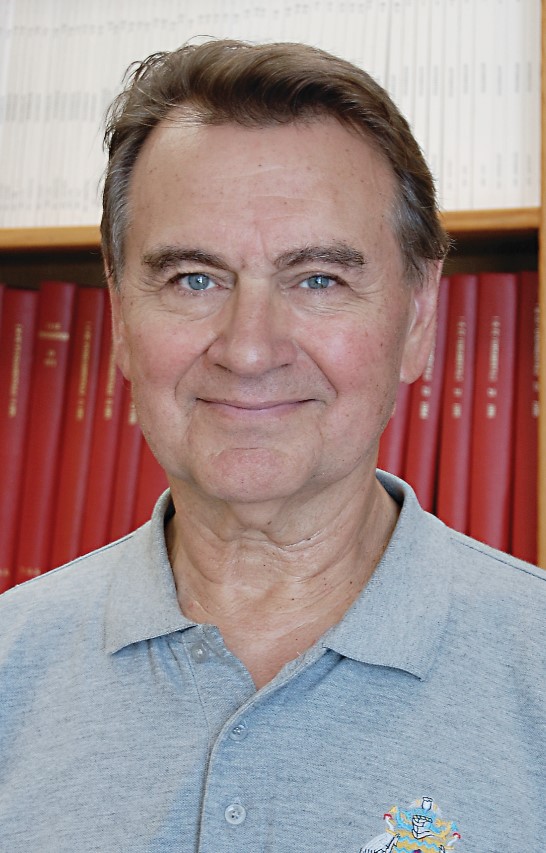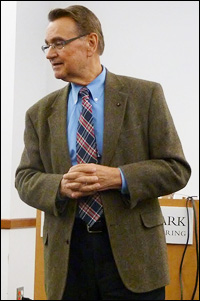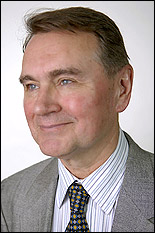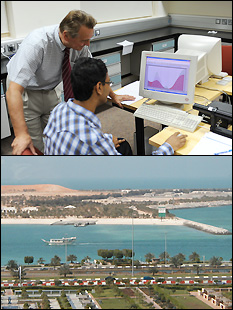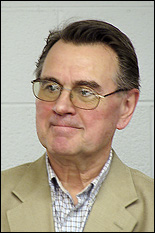News Story
Anisimov Group Makes Its Mark

Left to right: Adedayo Adeniran, Kirt Linegar, and Daphne Fuentevilla.
In the spring, undergraduate research student Adedayo Adeniran won third place for her presentation at the First Annual Louis Stokes Alliance for Minority Participation (LSAMP) Undergraduate Research Symposium, where she discussed the results of the research in which she was involved throughout the previous academic year.
Her project involved using dynamic light scattering (DLS) to discover whether the change in the particle size of a polymer could be observed. DLS is a technique in which a light source with a known frequency—often a laser, as in Anisimov's lab—is used to measure particle or droplet size and distribution at the nanometer or micron scale. When the light passes through a liquid in which particles are suspended, it diffracts (bends, or scatters), resulting in a change of its frequency. Researchers are then able to correlate these changes with specific particle properties.
"The research is important because it will hopefully show that dynamic light scattering can be another analytic tool to observe conformational changes of polymers and other materials," Adenirian explains. "It also may help make dynamic light scattering become a more standard analytical tool."
This summer, graduate student Kirt Linegar attended the Gordon Conference on Liquid Crystals in New London, NH, a trip sponsored by the Department. Linegar presented a poster titled "Dynamic Modes in Liquid Crystal Solutions of Cromolyn." The project, which is also rooted in the use of DLS, seeks to quantify the significant fluctuations in the density of liquid crystal particles encountered at the nanoscale, and how long they last. Understanding this behavior could help engineers developing nanoscale technology for use in products such as flat panel televisions and handheld devices.
"It was a big privilege for a first year grad student to be able to attend such a prestigious conference," Linegar says of the experience. "The presentation was very successful, and it was great to represent Maryland."
Graduate student Daphne Fuentevilla, who also works for the United States Navy as a civilian engineer, has received a Department of Defense SMART Scholarship, which provides support for science, technology, engineering, and mathematics students in exchange for civilian service with the DOD after graduation. SMART scholars receive full tuition, a $1000/year book stipend, a stipend up to $41,000 (based on prior experience and academic degree), and employment with the DOD.
Fuentevilla, who completed her Masters degree in August 2007 and is now pursuing a doctorate in the Department, is very happy about the arrangement, telling us, "I am very thankful for my scholarship because it allows me to maintain my full-time employee status with my job, something that is very important for me for my future career plans, while also giving me more time to spend on my research, something I felt I needed in order to attempt the Ph.D."
This summer Fuentevilla and Anisimov attended two international thermodynamic conferences: the 11th International Conference on Properties and Phase Equilibrium, held in Hersonissos, Crete; and the 16th International Conference on Chemical Thermodynamics, held in Suzdal, Russia. Fuentevilla presented a poster in Crete and a talk in Russia, both related to her Masters thesis, "A Scaled Equation of State for a Liquid-Liquid Critical Point in Supercooled Water." The work, which examines the unusual behavior of liquid water at near-freezing and lower temperatures, provides a thermodynamic perspective on the theory that there may be a low temperature critical point at which water shifts from its typical liquid phase into two liquid phases of a different density before freezing. Fuentevilla and Anisimov have published the results of this work in Physical Review Letters, one of the most prestigious among international research journals.
To learn more about these projects, visit the Anisimov/Sengers Research Group page »
Published September 20, 2007
